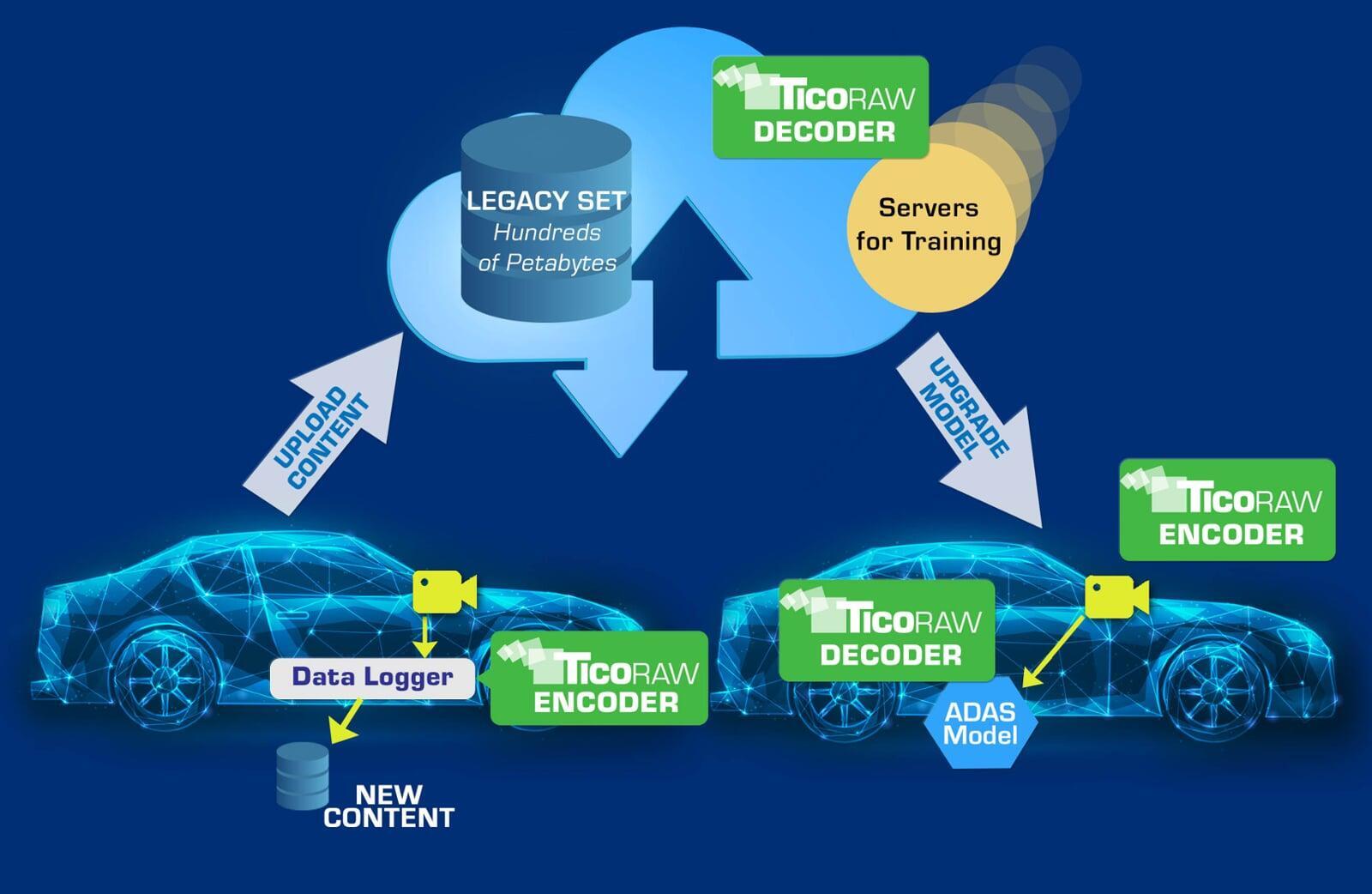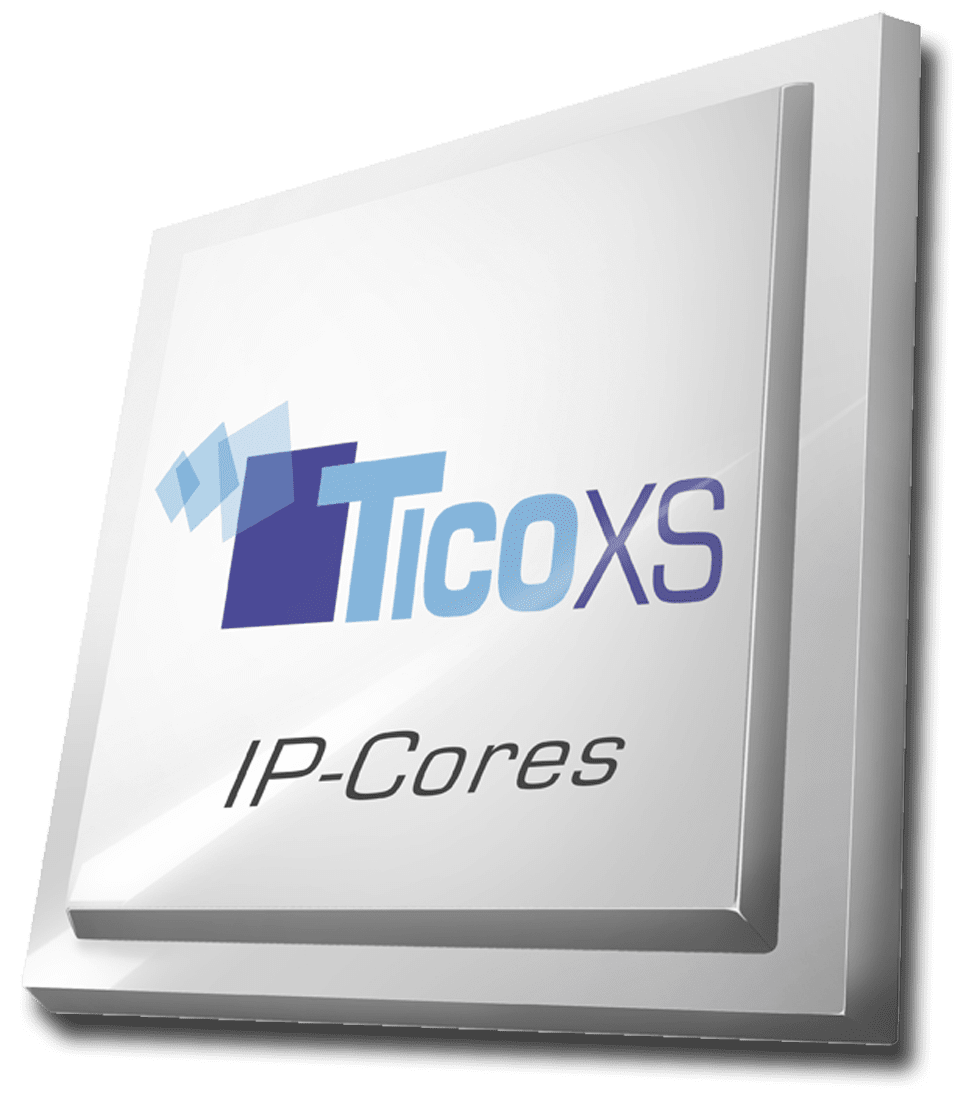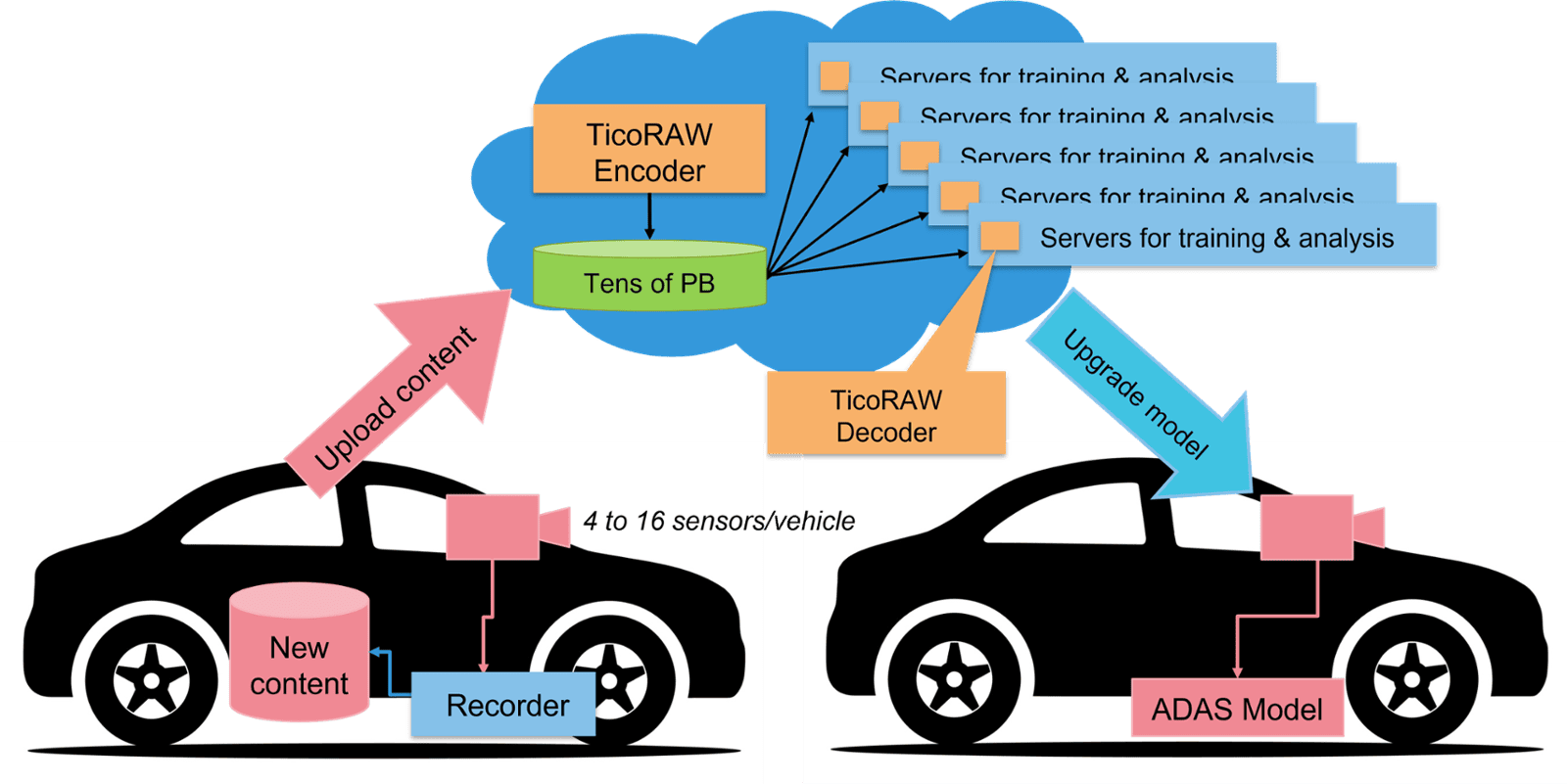COMPRESSION DRIVING AUTOMOTIVE VIDEO SOLUTIONS
intoPIX brings cutting-edge image compression technology to the automotive industry, delivering high-quality, low-latency video solutions for Advanced Driver Assistance Systems (ADAS), infotainment, and autonomous driving. Our expertise in JPEG XS and other innovative codecs ensures superior performance, reliability, and efficiency for in-vehicle video streaming and data transfer.
High Quality & Low Latency
Delivering crisp, real-time video for critical automotive applications.
Scalable & Flexible Solutions
Adaptable to diverse automotive systems and architectures.
High-performance Video Transport for ADAS Applications
High-performance Video Transport for ADAS Applications
CLOUD INFRASTRUCTURE
Are you looking to optimize your storage resources and continually improve your ADAS models with cloud infrastructure?
Perception is achieved through AI networks trained on images collected worldwide and stored in the cloud for training. Our software libraries, optimized for CPUs and GPUs, enable the compression of these training sets, specifically designed to enhance ADAS (Advanced Driver Assistance Systems) models. The initial dataset can be archived, while the compressed set is used daily. Decoding occurs in real-time during training.
- Reduced Storage Costs: The amount of data needed to store images can be reduced by a factor of 5 to 10, significantly lowering storage costs in data warehouses. Large data storage on Public Cloud rapidly becomes too costly and completely unreasonable.
- Continuous Improvement of ADAS Models: Cost reduction helps overcome budget constraints, allowing ongoing development of ADAS models over time, ensuring more precise and higher quality models.

DATA LOGGER
Are you aiming to reduce storage costs, speed up cloud uploads, and streamline data management by recoding and compressing images efficiently?
Images are recorded by cars traveling around the world. These cars are equipped with data loggers that store the images before they are transferred to the cloud. Our IP core hardware for FPGAs or ASICs and our software libraries can be used to compress stored images.
- Cost-Effective Storage: Compression allows for more images to be stored on data loggers, significantly reducing storage costs.
- Faster Upload Times: Compression decreases upload times to the cloud, improving overall efficiency.
- Seamless Data Increment: The training set can be incremented without needing to recompress in the cloud, streamlining the data management process.

CAMERA SENSOR
Are you seeking to enhance image quality, and reduce power consumption directly within your camera sensors?
Over time, JPEG XS RAW will become the de facto standard for automotive image transmission and can be integrated directly into image sensors using our low-power ASIC solutions. Decoding can be performed directly on ADAS platforms using our GPU libraries and/or dedicated hardware.
- Reduced Power Consumption: Reducing the data transfer rate to the central processor will decrease the power required by the camera module, eliminating overheating issues.
- Enhanced Image Quality: ECU will no longer be limited by the bandwidth of their physical interface, allowing higher resolutions, frame rates, or bit depth of images, leading to higher quality perception.

Discover intoPIX High-Performance Video Solutions
The world first low-latency sensor and video compression built up for automotive
TicoRAW for Automotive Sensor Data
Our TicoRAW solutions enable to optimize RAW Bayer (& other CFA data) during the capture, transfer, storage and machine learning at the speed of light. Low power in camera, it enables to capture, store and stream RAW (CFA, Bayer), including HDR at the 10X reduced size and bandwidth. Our range of FPGA & ASIC cores (encoder/decoder) supports high resolution (from 2Mpixels to 200Mpixels), at 30, 60, 120 fps (or beyond), handling RGGB, RYYCy, RCCC, and other CFA pattern from 8 to 16bit.
Lossless (mathematically) compression capability is also an intrinsic feature. Our encoding / decoding software libraries target x86-64 CPU , ARM64 CPU & Nvidia GPUs with unbelievable performances! The software capability is also a key benefit for the data acquisition in the vehicle for development purpose.


JPEG XS for Automotive Video Connectivity (TicoXS)
intoPIX has a large range of JPEG XS implementations from IP cores for FPGA & ASIC to software libraries. The new lightweight low-latency ISO standard is design to replace uncompressed video, preserving a microsecond latency, a lossless quality with a minimal encoding/decoding complexity, which perfectly answer the needs of the automotive industry.
The Ultimate Benefits of intoPIX ADAS Solutions
| TicoRAW | TicoXS | |
|---|---|---|
| Extremely low latency | | |
| Pristine Quality Lossless for Human or Machine Vision | | |
| Empower perception systems | | |
| RAW compression for image sensor | | |
| Lower bandwidth | | |
| Reduced cost and power consumption in devices | | |
| High resolution supported | | |
| Compliant with MIPI interfaces or Automotive Ethernet | | |
| Less interfaces, Less cables, Less storage | | |
TicoRAW Bandwidth-Reduction example
for Sensor Data Interfacing over MIPI or over Auto Ethernet
With a TicoRAW sensor compression at 4:1 for example (as in the tables hereunder), it will use (at least) 4x less bandwidth or support (at least) 4x more resolution on same bandwidth, same number of MIPI lane, or transport 4x more sensors on the same wire.
Note that TicoRAW could compress down to 10:1 and go below 1 Gbps for many formats mentioned hereunder.
| < 2.5 Gbps |
| < 5 Gbps |
| < 10 Gbps |
Regular RAW (in Gbit/sec)
| Format | Fps | 8 bit | 10 bit | 12 bit | 14 bit | 16 bit |
|---|---|---|---|---|---|---|
| 1MP/720p | 30 | 0.22 | 0.28 | 0.33 | 0.39 | 0.44 |
| 1MP/720p | 60 | 0.44 | 0.55 | 0.66 | 0.77 | 0.88 |
| 2MP/1080p | 30 | 0.50 | 0.62 | 0.75 | 0.87 | 1.00 |
| 2MP/1080p | 60 | 1.00 | 1.24 | 1.49 | 1.74 | 1.99 |
| 4MP | 30 | 0.91 | 1.13 | 1.36 | 1.59 | 1.81 |
| 4MP | 60 | 1.81 | 2.27 | 2.72 | 3.1 | 3.63 |
| 4K UltraHD | 30 | 1.99 | 2.49 | 2.99 | 3.48 | 3.98 |
| 4K UltraHD | 60 | 3.98 | 4.98 | 5.97 | 6.97 | 7.96 |
| 10MP | 30 | 2.26 | 2.83 | 3.40 | 3.96 | 4.53 |
| 10MP | 60 | 4.53 | 5.66 | 6.79 | 7.93 | 9. 06 |
TicoRAW (in Gbit/sec)
| Format | Fps | 8 bit | 10 bit | 12 bit | 14 bit | 16 bit |
|---|---|---|---|---|---|---|
| 1MP/720p | 30 | 0.06 | 0.07 | 0.08 | 0.10 | 0.11 |
| 1MP/720p | 60 | 0.11 | 0.14 | 0.17 | 0.19 | 0.22 |
| 2MP/1080p | 30 | 0.12 | 0.16 | 0.19 | 0.22 | 0.25 |
| 2MP/1080p | 60 | 0.25 | 0.31 | 0.37 | 0.44 | 0.50 |
| 4MP | 30 | 0.23 | 0.28 | 0.34 | 0.40 | 0.45 |
| 4MP | 60 | 0.45 | 0.57 | 0.68 | 0.78 | 0.91 |
| 4K UltraHD | 30 | 0.25 | 0.62 | 0.75 | 0.87 | 1.00 |
| 4K UltraHD | 60 | 1.00 | 1.25 | 1.49 | 1.74 | 1.99 |
| 10MP | 30 | 0.57 | 0.71 | 0.85 | 0.99 | 1.13 |
| 10MP | 60 | 1.13 | 1.41 | 1.70 | 1.98 | 2.27 |

Get the intoPIX Automotive
PRESENTATION
Transforming Automotive Applications with Our Solutions
Are you looking to optimize your storage resources and continually improve your ADAS models with cloud infrastructure ?
Perception is achieved through AI networks trained on images collected worldwide and stored in the cloud for training. Our software libraries, optimized for CPUs and GPUs, enable the compression of these training sets, specifically designed to enhance ADAS (Advanced Driver Assistance Systems) models. The initial dataset can be archived, while the compressed set is used daily. Decoding occurs in real-time during training.

- Reduced Storage Costs: The amount of data needed to store images can be reduced by a factor of 5 to 10, significantly lowering storage costs in data warehouses. Large data storage on Public Cloud rapidly becomes too costly and completely unreasonable.
- Continuous Improvement of ADAS Models: Cost reduction helps overcome budget constraints, allowing ongoing development of ADAS models over time, ensuring more precise and higher quality models.
Are you aiming to reduce storage costs, speed up cloud uploads, and streamline data management by recoding and compressing images efficiently ?
Images are recorded by cars traveling around the world. These cars are equipped with data loggers that store the images before they are transferred to the cloud. Our IP core hardware for FPGAs or ASICs and our software libraries can be used to compress stored images.

- Cost-Effective Storage: Compression allows for more images to be stored on data loggers, significantly reducing storage costs.
- Faster Upload Times: Compression decreases upload times to the cloud, improving overall efficiency.
- Seamless Data Increment: The training set can be incremented without needing to recompress in the cloud, streamlining the data management process.
Are you seeking to enhance image quality, and reduce power consumption directly within your camera sensors?
Over time, JPEG XS RAW will become the de facto standard for automotive image transmission and can be integrated directly into image sensors using our low-power ASIC solutions. Decoding can be performed directly on ADAS platforms using our GPU libraries and/or dedicated hardware.

- Reduced Power Consumption: Reducing the data transfer rate to the central processor will decrease the power required by the camera module, eliminating overheating issues.
- Enhanced Image Quality: ECU will no longer be limited by the bandwidth of their physical interface, allowing for higher resolution, frame rates, or bit depth of images, leading to higher quality perception.
The Challenges of the Autonomous Vehicles
For autonomous driving, multiple sensors are combined and their data transmitted to a so-called ECU (Electronic Central Unit) in which the data from the sensors are jointly analyzed and related actions calculated. Data from these sensors need to be processed with maximum responsiveness, therefore implying a very low latency along the whole dataflow.
In terms of implementation and given the number of sensors, power consumption needs to be constrained as much as possible. The cabling inside the car is also critical. High-resolution cameras and limited interface bandwidths require smart compression to reduce the bandwidth during low-latency transmission and/or aggregating multiple sensor streams on one port/cable. Our solutions are suitable for any protocols such as MIPI or Automotive Ethernet and run on FPGA, ASIC, CPU or GPU.


The in-car transmission - or infotainment - is a collection of hardware and software in vehicles that provides audio or video entertainment as automotive navigation systems, video players, USB and Bluetooth connectivity, Carputers, in-car internet, and WiFi. intoPIX enables to transmit video with lossless quality & microsecond latency, with new technology such as JPEG XS (see TicoXS)
Automotive always requires more cameras that generate an incredible amount of data and thus heavier bandwidth.
Our objective with new RAW CFA compression (see TicoRAW) is to avoid the multiplication of heavy cables that would imply extra cost, extra space requirement and extra power consumption. Furthermore, in this kind of extremely sensitive use, we cannot afford to neglect the latency; the slightest delay could have catastrophic consequences.









